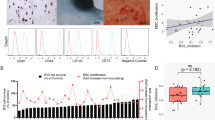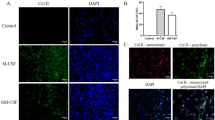Abstract
Hematopoietic cell growth, differentiation, and commitment to a restricted lineage are guided by a set of cytokines acting exclusively on cells expressing the corresponding cytokine receptor. The macrophage colony stimulating factor (M-CSF, also termed CSF-1) and its cognate receptor, the tyrosine kinase c-Fms, are essential for monocyte and macrophage development. The underlying molecular mechanism, however, is poorly understood. Here we identified a novel Fms-interacting protein (FMIP, MW 78 kDa) which binds transiently via its N-terminal 144 residues to the cytoplasmic domain of activated Fms-molecules. Binding of FMIP was paralleled by rapid tyrosine phosphorylation within the binding domain which drastically reduced its ability to associate with Fms. Binding was specific as evidenced by co-immunoprecipitation and association with recombinant GST-Fms fusion proteins. No binding was observed with the tyrosine phosphorylated cytoplasmic domains of c-Kit, TrkA, c-Met, and the insulin receptor. The role of FMIP in hematopoietic differentiation was studied in the bipotential myeloid progenitor cell line, FDC-P1Mac11. Overexpression of FMIP prevented M-CSF induced macrophage differentiation. Instead, cells differentiated into granulocytes. Our data suggest that the level of FMIP expression could form a threshold that decides about differentiation either into macrophages or into granulocytes.
This is a preview of subscription content, access via your institution
Access options
Subscribe to this journal
Receive 50 print issues and online access
$259.00 per year
only $5.18 per issue
Buy this article
- Purchase on SpringerLink
- Instant access to full article PDF
Prices may be subject to local taxes which are calculated during checkout








Similar content being viewed by others
References
Bourette RB, Myles GM, Choi J-L and Rohrschneider R. . 1997 EMBO J. 16: 5880–5893.
Broudy VC. . 1997 Blood 90: 1345–1364.
Courtneidge SA, Dhand R, Pilat D, Twamley GM, Waterfield MD and Roussel MF. . 1993 EMBO J. 12: 943–950.
Cross MA, Heyworth CM and Dexter TM. . 1997 In: The Molecular Basis of Cellular Defence Mechanisms. Ciba Foundation Symposium. John Wiley & Sons: New York. pp. 3–16.
Field S and Song O-K. . 1989 Nature 340: 245–246.
Gliniak SC and Rohrschneider RL. . 1990 Cell 63: 1073–1083.
Helftenbein G, Krusekopf K, Just U, Cross M, Ostertag W, Niemann H and Tamura T. . 1996 Oncogene 12: 931–935.
Joos H, Trouliaris S, Helftenbein G, Niemann H and Tamura T. . 1996 J. Biol. Chem. 271: 24476–24481.
Just U, Friel J, Heberlein C, Tamura T, Baccarini M, Tessmer U, Klingler K and Ostertag W. . 1993 Growth Factors 9: 291–300.
Lioubin MN, Algate PA, Tsai S, Carlberg K, Aebersold R and Rohrschneider LR. . 1996 Genes Dev. 10: 1084–1095.
Mancini A, Niedenthal R, Joos H, Koch A, Trouliaris S, Niemann H and Tamura T. . 1997 Oncogene 15: 1565–1572.
Novak U, Nice E, Hamilton JA and Paradiso L. . 1996 Oncogene 13: 2607–2613.
Pawson T and Scott JD. . 1997 Science 278: 2075–2080.
Pierce A, Heyworth CM, Nicholls SE, Spoocer E, Dexter TM, Lord JM, Owen-Lynch PJ, Wark G and Whetton AD. . 1998 J. Cell Biol. 140: 1511–1518.
Quelle FW, Sato N, Witthuhn BA, Inhorn RC, Eder M, Miyajima A, Griffin JD and Ihle JN. . 1994 Mol. Cell Biol. 14: 4335–4341.
Reedijk M, Liu X, van der Geer P, Letwin K, Waterfield MD, Hunter T and Pawson T. . 1992 EMBO J. 11: 1365–1372.
Songyang Z, Shoelson SE, Chaudhuri M, Gish G, Pawson T, Haser WG, King F, Roberts T, Ratnofsky S, Lechleider RJ, Neel BG, Birge RB, Fajardo JE, Chou MM, Hanafusa H, Schaffhausen B and Cantley LC. . 1993 Cell 72: 767–778.
Tamura T, Simon E, Niemann H, Snoek GT and Bauer H. . 1986 Mol. Cell. Biol. 6: 4745–4748.
Trouliaris S, Smola U, Chang J-H, Parsons SJ, Niemann H and Tamura T. . 1995 J. Virol. 69: 6010–6020.
Ullrich A and Schlessinger J. . 1990 Cell 61: 203–212.
van der Geer P and Hunter T. . 1993 EMBO J. 12: 5161–5172.
Vojtek AB, Hollenberg SM and Cooper JA. . 1993 Cell 74: 205–214.
Weidner KM, Di Cesare S, Sachs M, Brinkmann V, Behrens J and Birchmeier W. . 1996 Nature 384: 173–176.
Whetton AD, Heyworth CM, Nicholls SE, Evans CA, Lord JM, Dexter TM and Owen-Lynch PJ. . 1994 J. Cell Biol. 125: 651–659.
Xie Y-G, Han F-Y, Peyrard M, Ruttledge MH, Fransson I, DeJong P, Collins J, Dunham I, Nordenskjöld M and Dumanski JP. . 1993 Human Mol. Genet. 2: 1361–1368.
Yasukawa T, Kanei-Ishii C, Maekawa T, Fujimoto J, Yamamoto T and Ishii S. . 1995 J. Biol. Chem. 270: 25328–25331.
Yokouchi M, Suzuki R, Masuhara M, Komiya S, Inoue A and Yoshimura A. . 1997 Oncogene 15: 7–15.
Acknowledgements
We thank Walter Birchmeier for helping with the establishment of the two-hybrid system and Rainer Niedenthal and Karsten Heidrich for FACS-analyses. The research was supported by the Deutsche Forschungsgemeinschaft (Ta-111/7/-1), IHFSP, and Fonds der Chemischen Industrie to H Niemann.
Author information
Authors and Affiliations
Rights and permissions
About this article
Cite this article
Tamura, T., Mancini, A., Joos, H. et al. FMIP, a novel Fms-interacting protein, affects granulocyte/macrophage differentiation. Oncogene 18, 6488–6495 (1999). https://doi.org/10.1038/sj.onc.1203062
Received:
Revised:
Accepted:
Published:
Issue date:
DOI: https://doi.org/10.1038/sj.onc.1203062
Keywords
This article is cited by
-
Myc/Max dependent intronic long antisense noncoding RNA, EVA1A-AS, suppresses the expression of Myc/Max dependent anti-proliferating gene EVA1A in a U2 dependent manner
Scientific Reports (2019)
-
Myc target gene, long intergenic noncoding RNA, Linc00176 in hepatocellular carcinoma regulates cell cycle and cell survival by titrating tumor suppressor microRNAs
Oncogene (2018)
-
Depletion of three combined THOC5 mRNA export protein target genes synergistically induces human hepatocellular carcinoma cell death
Oncogene (2016)
-
THOC5, a member of the mRNA export complex: a novel link between mRNA export machinery and signal transduction pathways in cell proliferation and differentiation
Cell Communication and Signaling (2014)
-
THOC5, a member of the mRNA export complex, contributes to processing of a subset of wingless/integrated (Wnt) target mRNAs and integrity of the gut epithelial barrier
BMC Cell Biology (2013)



